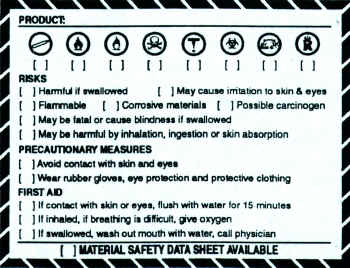 WHMIS Test
WHMIS Test
1) What does the acronym 'WHMIS' stand for?![]()
2) What important information is provided on a WHMIS-approved label?
3)Another source of product information is the Material Safety Data Sheet (MSDS). These are usually located in classrooms or in work areas where reactive materials are used and must be provided by retail outlets upon request. How does the information given on the WHMIS label differ from the MSDS?
| 1. |
| 2. |
| 3. |
| 4. |
4) Match each hazard class with its appropriate symbol, and then find the corresponding statement that describes a material that would fall into this hazard class. The symbols and corresponding statements are given on the next page. The first hazard class has been done for you.
WHMIS Symbols:
 |
Hazard Class |
Symbol |
Corresponding |
Corrosive |
G |
6 |
|
| Compressed Gas |
|||
Poisonous and Infectious Material |
|||
Biohazardous |
|||
Dangerously |
|||
Oxidizing |
|||
Flammable and |
|||
Poisonous and Infectious |
2.Acetonitrile can react violently with water to produce a toxic gas.
3.The Hepatitis B virus can cause a disease marked by such symptoms as fatigue, loss of appetite, nausea and jaundice.
4.Turpentine has a flash point (temperature at which gaseous material ignites) is 35 °C.
5.A tank of compressed oxygen can pose any number of hazards if a leaky cylinder, hose or valve allows the gas to escape.
6.Sodium hydroxide, also known as caustic soda, can seriously burn the eyes and skin upon contact.
7.Epoxy resins, especially after repeated exposure, can cause an allergic reaction of the skin, resulting in redness, blistering and itchiness.
8. Chromic acid is not flammable in itself, but can cause a fire when it comes into contact with combustible materials.
CLASSIFICATION OF MATERIALS
5) MATCH THE FOLLOWING STATEMENTS WITH A SUITABLE WHMIS SYMBOL
AT THE BOTTOM OF THE PAGE, WRITE THE APPROPRIATE LETTER IN THE
BLANK PROVIDED. EACH QUESTION IS WORTH 1 MARK.
[Total = 10 Marks]
Questions:
1)High levels of Spray Varnish can cause nausea, dizziness, and disorientation seconds after exposure, depending on a persons tolerance.
2)Trisodium Phosphate (TSP a brush cleaning agent) can react violently with water to produce a toxic gas.
3)The heavy metal lead ingestion can produce symptoms such as fatigue, loss of appetite,
dementia, nausea, weakness and hair loss.
4)Turpentine has a flash point (temperature at which gaseous material ignites) of
35 °C.5)
In plaster calcium hydroxide, also known as slaked lime, is corrosive and may cause burns to skin and eyes, or an irritating rash.6)Lacquer thinner should be handled under proper ventilation, with skin and eye protection as it may cause gastrointestinal and lung irritation, abdominal pains, liver damage, vomiting or diarrhea.
7)A tank of compressed acetylene (jewelry making) can pose serious life threatening hazards if a leaky cylinder, hose or valve allows the gas to escape.
8)Soldering flux, which has an acid base, can seriously burn the eyes and skin upon contact and should be handled with caution.
9)Fibre-glass resins, especially after repeated exposure, can cause an allergic reaction of the skin, resulting in redness, blistering and itchiness.
10)Linseed oil is mildly flammable in itself, but can cause a spontaneous fire when it comes into prolonged contact with combustible materials, such as a cloth or paper.
1)____ 2) 3) 4) 5) 6) 7) 8) 9) 10)

6) Identify what each WHMIS symbol stands for by completing the table below:
WHMIS SYMBOL |
Description |
 |
|
 |
|
 |
|
 |
|
 |
|
 |
|
 |
|
 |
Total number of points:_______________
